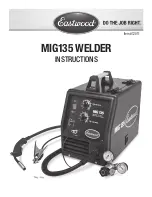
12
Eastwood Technical Assistance: 800.343.9353 >> [email protected]
WELDING PROCESS
Your Eastwood MIG135 can be used to form a large number of different joints and welds all of which will require practice
and testing before using on an actual project piece. This welding process is just a baseline to get you started.
1.
Refer to the ‘Suggested Settings’ chart which is located inside the side door of your Eastwood MIG135 as well as below in the instruction manual.
From the chart select your baseline starting point for the recommended settings described in the chart.
2.
Change the output polarity, if necessary, according to the welding wire’s specifications. This welder comes set up
to use Solid MIG wire. If using Flux Cored wire, the polarity will need to be changed.
3.
Connect your ground clamp to the work pieces that are to be welded. Make sure the ground clamp contacts are placed
on a clean piece of metal free of paint, grease, rust, oils, etc. It is recommended to place your ground clamp as close
to the weld area as possible.
4.
Assess your weld area and make sure the welding area is also cleaned of any paint, grease, rust, oils, etc.
5.
Plug in the welder and switch to the ON position.
6.
Open your gas valve on the bottle and adjust the flow rate if necessary.
7.
Depress the MIG Gun trigger pointing the welding gun away from your body and then let go of the trigger and
cut the wire back to ~1/4” stick out length.
8.
Wearing your welding helmet, gloves, and long sleeve shirt and pants, put the end of the wire sticking out of
the gun into the joint to be welded.
9.
Position the MIG Gun so that it is perpendicular to the base metal with ~20° tilt back.
10.
Depress the trigger to start the wire feed which starts the arc. NOTE: A push, perpendicular, or drag technique can be used to weld the pieces together;
the type used depends on the type of joint as well as other influential conditions.
11.
Once you depress the trigger and the arc has started, you will notice a molten puddle will form; this puddle is the weld bead and will follow the motion of
the MIG Gun. Watching the size of the puddle dictates how fast you should be moving with the torch. If you burn through the material you are either moving
to slow or you need to make some setting adjustments to the welder settings. If you’re not penetrating the base metal you’re either moving too fast or you
need to make adjustments to the welder settings.
12.
Release the trigger on the MIG Gun to stop the weld.
13.
After finished welding, close the valve completely on the Shielding Gas Bottle.
ARC RAYS CAN BURN!
• Arc rays produce intense ultraviolet radiation which can burn exposed skin and cause eye damage. Use a shield with the proper
filter (a minimum of #11) to protect your eyes from sparks and the rays of the arc when welding or when observing open arc
welding (see ANSI Z49.1 and Z87.1 for safety standards).
• Use suitable clothing made from durable flame-resistant material to protect your skin.
• If other persons or pets are in the area of welding, use welding screens to protect bystanders from sparks and arc rays.
FUMES AND WELDING GASES CAN BE A HEALTH HAZARD!
• Fumes and gasses released during welding are hazardous. Do not breathe fumes that are produced by the welding operation.
Wear an OSHA-approved respirator when welding.
• Always work in a properly ventilated area.
• Never weld coated materials including but not limited to: cadmium plated, galvanized, lead based paints.
HOT METAL AND TOOLS WILL BURN!
• Electric welding heats metal and tools to temperatures that will cause severe burns!
• Use protective, heat resistant gloves and clothing when using Eastwood or any other welding equipment.
Never touch welded work surface, torch tip or nozzle until they have completely cooled
















